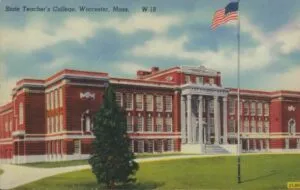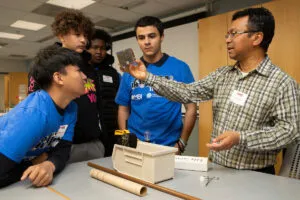Antique telescope collection opens up the universe for students and faculty
Worcester State students can now reach for the stars thanks to a recent long-term loan of modern and antique telescopes that promise to offer a stellar opportunity for learning and research.
The collection was amassed by the late Charles Blumsack, a lawyer and avid amateur astronomer, and includes 18 telescopes, most of them antiques, as well as mounts, accessories, and other materials. They have been loaned to the university by Charles’s widow, Cynthia Blumsack, a retired teacher who requested that they be used for educational purposes by Worcester State students and faculty and the public.
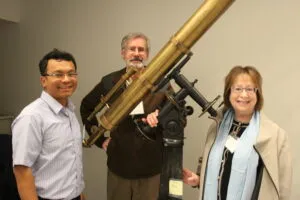
Physics professor Nabin Malakar with Kim Lemerise of the Aldrich Astronomical Society and Cynthia Blumsack, who loaned the telescopes to Worcester State.
The collection has been appraised at $100,000 and is on loan to Worcester State for 25 years. The telescopes are currently being stored in the university’s astronomy supply room, with plans to place some of them in display cases throughout the Ghosh Science & Technology Center hallways. A donation to the university astronomy fund by Robert Kolesnik ’72, adjunct astronomy instructor, has helped to support the project, including covering the cost of moving the collection to campus, cleaning and repairing the telescopes, and building display cases.
The telescope collection benefits Worcester State by providing valuable equipment for students and faculty to use, according to Provost Lois Wims. It allows students to engage in astronomy and astrophotography and to conduct research related to star formation. The collection also enhances the university’s capacity to offer its new minor in astronomy, fulfilling an interest expressed by students, Wims said.
The Ghosh Science & Technology Center, which opened in 2000, has allowed the university to invest in STEM fields such as computer science, biology, biotech, earth sciences, physics, nursing, communication science disorders, and occupational therapy. Worcester State is the first of the nine Massachusetts state universities to have a building dedicated to science, technology, and health-related programs.
“The university is now excited to also celebrate astronomy and has developed a strong core of physics faculty with expertise in the field,” Wims said. “The Blumsack collection will be an essential part of building the university’s capacity in astronomy, and the university is grateful to Cynthia for loaning the collection and has promised to preserve and display each piece with care.”
Mrs. Blumsack worked with representatives of the university and the Aldrich Astronomical Society, a venerable local astronomy club, to bring the collection to Worcester State, where it will reflect Charles’s passion and promote his desire to inspire the next generation of stargazers.
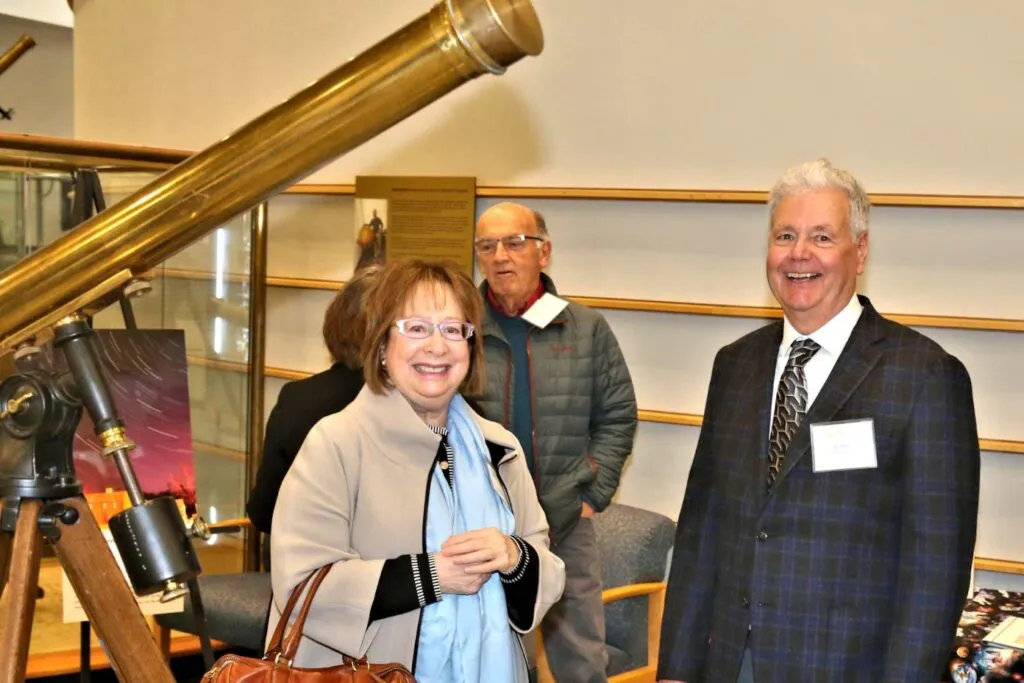
Mrs. Blumsack with Robert Kolesnik ’72, adjunct astronomy instructor.
The Aldrich Astronomical Society has had a longstanding relationship with Worcester State and the society president, Jim Zebrowski. Aldrich members Kim Lemerise, Kevin Boucher, and Kolesnik are among the key partners who have been assisting the university in integrating the collection into the Worcester State curriculum. Linda Larrivee, dean of the School of Science, Technology and Health, played a key role in getting this collection together for use by Worcester State students, and the University Advancement staff, led by Vice President Tom McNamara, also was instrumental in making the connection, Wims said.
The collection includes two modern telescopes, several antique telescopes from the former Alvan Clark & Sons company of Cambridgeport, Mass., and telescopes from other manufacturers from around the world. The Alvan Clark telescopes are instruments of exceptional quality that were highly regarded in their time, Kolesnik said. Alvan Clark was a renowned telescope maker who sold his first telescope in 1848. His telescopes played a crucial role in the development of astrophysics and were used for the first astrophotography and spectrum measurement of stars, he said.
Modern astronomy uses computerized methods to correctly position telescopes, but the antique telescopes will allow students to have hands-on experience and gain practical skills that they wouldn’t get from using an app, according to Nabin Malakar, associate professor of physics.
“Aligning the telescope manually requires skill and technical thinking, which the app cannot provide,” he said. “Also, looking through a telescope allows students to see the stars directly and have a more immersive experience compared to just viewing signals on an app.” Malakar plans to use the telescopes in some of his classes, including an astrophotography course planned for fall 2024.
Andrew Burkhardt, assistant professor of physics, emphasized the importance of learning and teaching students how to use traditional telescopes.
“Most modern astronomy is very automated or run by professional operators, so it is useful for students to learn how the mechanics of everything works,” Burkhardt said. “These telescopes are elegant in their ease of use, and their designs help inform how and why we build telescopes today. Also, these telescopes really work just as well—if not better—than similar telescopes today.”
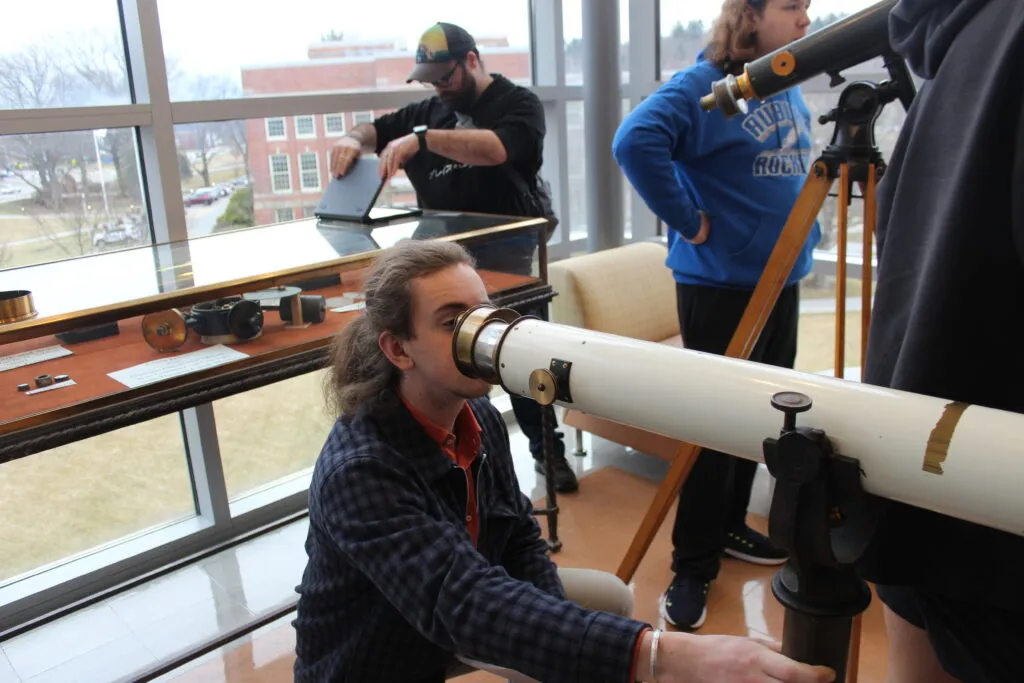
Undergraduate Aidan Desilets tries out one of the telescopes in the collection.
Kolesnik said the Alvan Clark telescopes were known for their exceptional quality and precision. They are handmade refracting telescopes, which were considered the highest-quality optical instruments of their time. Their lenses were ground meticulously, resulting in clear and detailed views of celestial objects.
The telescopes’ optics were handmade by Alvin Clark himself, who was known for his meticulous craftsmanship. “The lenses were polished to such a high degree because Clark could feel imperfections like a bump or a groove that was smaller than several wavelengths of light on the glass,” Kolesnik said.
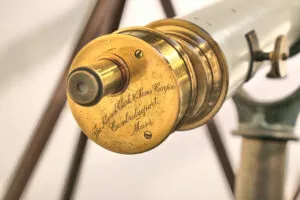
The collection includes two modern telescopes, and several antique telescopes from the former Alvan Clark & Sons company of Cambridgeport, Mass.
The collection had been in storage for many years, so much work needed to be done when the telescopes arrived at Worcester State. This task was made more challenging by the fact that they were custom-made, with each one being unique and tailored to the specific order.
Kolesnik and other members of the Aldrich Astronomical Society took each telescope out of its box and disassembled them, finding that some were usable while others needed extensive repairs.
“We had to figure out how to take them apart, and then we’d go to the next one and say, ‘We’re going to start all over again. This one is totally different,’” Kolesnik said. When it came to evaluating and cleaning the optics, it was especially helpful that Kim Lemerise is an optical engineer. “This is his field,” Kolesnik said. “He spent more than 30 years doing this kind of thing, so he was in seventh heaven working on these.”
Alvan Clark telescopes are owned by many prestigious institutions such as the U.S. Naval Observatory and Amherst College. The Smithsonian Institution owns a version known as the Alvan Clark student telescope, of which there are only two in the world. The only other one now is at Worcester State, part of the Blumsack collection.
Preserving the collection of antique telescopes is important for historical, educational, and cultural reasons, Burkhardt said, because it allows us to honor the past, learn from it, and pass on this knowledge to future generations.
“I rarely have the chance to get my hands on telescopes such as these in my research,” he said. “As a radio astronomer, most of my observation experience is submitting codes and scripts to a telescope hundreds or thousands of miles away. Sometimes I even have to wait months to see the data, depending on the observatory. The Alvan Clark telescopes allow me to get back to the roots of what inspired me to do astronomy at a young age—just looking up at the night sky and seeing what is cool out there.”

